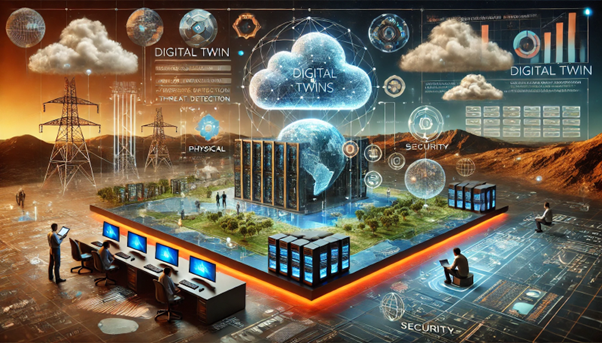A digital twin is a virtual representation of a physical object, system, or process that mirrors its real-world counterpart. This concept integrates data from various sources to create a dynamic model that can simulate, analyze, and predict the behavior of the physical entity throughout its lifecycle. The digital twin operates in real-time, continuously updating based on data collected through sensors and other inputs from the physical environment.

Key Components of a Digital Twin
1. Physical Entity: The actual object or system being represented, such as machinery, vehicles, or even entire cities.
2. Digital Representation: The virtual model that simulates the physical entity’s characteristics and behavior.
3. Data Link: The communication channel that connects the physical entity and its digital counterpart, enabling real-time data flow.
Historical Context
The concept of digital twins originated in the early 2000s but gained significant traction after NASA used similar models for spacecraft simulations. The term “digital twin” was formally introduced by Dr. Michael Grieves at the University of Michigan in 2002. Since then, advancements in Internet of Things (IoT) technology and data analytics have propelled the application of digital twins across various industries.
Applications of Digital Twins
Digital twins are utilized in numerous sectors, including:
1. Manufacturing: In smart factories, digital twins help optimize production processes by simulating operations, predicting equipment failures, and improving maintenance schedules.
2. Healthcare: Digital twins of patients can be created using health data to personalize treatment plans and predict health outcomes.
3. Urban Planning: Cities can use digital twins to model infrastructure, traffic patterns, and environmental impacts to enhance urban development strategies.
4. Automotive Industry: Manufacturers use digital twins to design vehicles and simulate performance under various conditions before physical prototypes are built.
5. Energy Sector: Digital twins of power plants or wind turbines allow operators to monitor performance in real-time and optimize energy production
Benefits of Digital Twins
-
- Enhanced Decision-Making: Digital twins provide valuable insights through simulations and predictive analytics, enabling organizations to make informed decisions based on real-time data.
- Improved Efficiency: By identifying inefficiencies and potential issues before they arise, digital twins can significantly reduce downtime and maintenance costs.
- Innovation Facilitation: Organizations can experiment with different scenarios in a virtual environment without the risks associated with physical trials, fostering innovation in product design and process optimization.
- Lifecycle Management: Digital twins support comprehensive lifecycle management by providing ongoing insights from design through operation to decommissioning.
Challenges and Considerations
While digital twins offer numerous benefits, several challenges must be addressed:
1. Data Security: The integration of IoT devices raises concerns about data privacy and cybersecurity risks.
2. Complexity: Developing accurate digital twins requires sophisticated modeling techniques and significant computational resources.
3. Interoperability: Ensuring that different systems and platforms can communicate effectively is crucial for maximizing the potential of digital twins.
Way Forward
The future of digital twin technology looks promising as advancements continue:
1. Integration with AI: The combination of AI with digital twin technology will enhance predictive capabilities and automate decision-making processes.
2. Expansion Across Industries: As awareness grows about the benefits of digital twins, their applications will expand beyond traditional sectors into areas like agriculture, logistics, and education.
3. Standardization Efforts: Industry standards for developing and implementing digital twins will emerge to ensure consistency and interoperability across platforms.
4. Edge Computing: The rise of edge computing will enable faster processing of data generated by IoT devices connected to digital twins, enhancing real-time analytics capabilities.
Conclusion
Digital twins represent a transformative technology with vast applications across multiple industries, enhancing efficiency, decision-making, and innovation. As organizations increasingly adopt this technology, understanding its components, benefits, challenges, and implications becomes essential for leveraging its full potential.
Spread the Word
